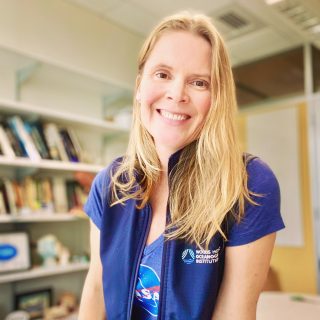Today was quite a day, and I’m still in the midst of it, so this might be short. When last I wrote we had just completed our first successful dive at Marker 113, collecting samples for viruses, microbiology, and chemistry. By midnight, due to hard work by both the ROPOS crew and our science team, we had managed to turn the vehicle and our instruments around and we were back in the water.

We made our way again to good old Marker 113. This time, we were armed with Dave Butterfield’s Hydrothermal Fluid and Particle Sampler. We fondly refer to the HFPS as “The Beast” because it is 1) very big, and 2) capable of taking a scary number of samples- 24! The Beast directs pumped water via a manifold into individual sample bottles or bags, often after the water passes through filters we use to collect microbes from the venting fluids.

There are also special filter units with a preservative in them that effectively stops the microbial cells’ genetic’ machinery as they hit the filter. This creates a snapshot of all the genes that were turned on, what they produced, and overall gene activity patterns, all of which we can determine through later analyses back in the lab. Such data help us answer questions like which microbes are the most critical producers of food in the subseafloor. Without that preservative, the cells would change in countless ways on their trip to the surface, and what we want to see is what the microbes are doing in their natural home.

Clearly, The Beast can do many things, and I’m quite fond of it. However, one thing it can’t do is collect those large volumes of water we gathered yesterday for viruses. This is why we did back to back dives to the same place but with two very different samplers . Collectively they give us what we need for a full range of analyses on viruses, microbes, and water chemistry. Our goal is to do all of this at a handful of sites so we can eventually build an ecosystem model for the subseafloor at each.
After filling up half of our sampler at Marker 113, we headed down south a few hundred meters to a site named Skadi, where we filled our sampler the rest of the way and then headed up. I caught a nap between 1 and 5 a.m., then finished the dive with Jim. We were back on deck by breakfast. Most of our science party had only slept a few hours, but delicious chocolate croissants helped us through the morning.
Faster, Faster
Very quickly, we turned the samples and vehicle around yet again and headed down by 11:30 a.m., this time with Lisa’s sampler. Our target was a site called Anemone. We found 230°C fluid there, which Giora was happy to sample with his gas tight sampler, but we also found cooler fluids—around 40 degrees—which was a fine range for Lisa’s viral sample. After a few hours on the seafloor, our collection bladders were full of vent fluids and it was time to come up.

But there was no time to rest between dives, as we had to turn everything around one last time. This was our fourth ROPOS launch in about a 30-hour period. We normally don’t work at such a crazy pace. But there is a major storm system on its way, so we are all pushing ourselves to make the most of this good weather window and to stay focused on our primary dive goals. The ship’s crew and ROPOS team are doing an awesome job of supporting our craziness, for which I am very thankful.
It’s approaching 9 p.m. now here on the Falkor, and I can see ROPOS is only a few hundred meters from the seafloor. I better make my way into the control van to get the work going. There are fluids to be sampled and microbes to be discovered.

